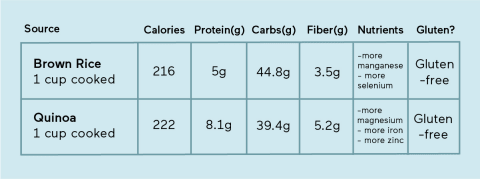Speaking of energy: White rice is a great option to eat before endurance exercise. “Simple carbs without a lot of extra insoluble fiber are the way to go the night before a race,” Amy Shah, M.D., previously told mbg. Carbs with soluble fiber are harder to digest and may lead to an upset stomach during intense or prolonged exercise. More nutritionally dense options for everyday eating include brown rice and black rice. “Black rice is one of the healthiest rice varieties, due in part to all the powerful antioxidants and phytonutrients (think the more intense the color, the higher in health-promoting nutrients),” certified culinary nutritionist and cookbook author Leah Vanderveldt writes for mbg. “It also contains fiber, iron, and copper along with protein.” How to use it: You can enjoy rice on its own or as a side to a protein like chicken, salmon, or tofu (here: a Japanese chef’s guide to making the perfect rice). Davis also likes pairing rice with Asian-inspired meals, like congee or sushi. “It’s gluten-free, high in protein, and contains nutrients like vitamin B, fiber, and various minerals (iron, calcium, zinc, and magnesium, to name a few) that boast a myriad of health benefits,” Smith writes. Registered dietitian Nour Zibdeh, M.S., RDN, calls quinoa one of the healthiest carbohydrates for blood sugar because of its high-protein and fiber content. Those nutrients also make it one of the best for boosting fullness and satiety, she adds. How to use it: “Quinoa is great for things like grain bowls, salads, and even a breakfast porridge,” Davis says. It can also be used as a substitute for rice in most dishes or served as a side. These nutritional components make quinoa more filling and better for blood sugar balance, Davis explains.



